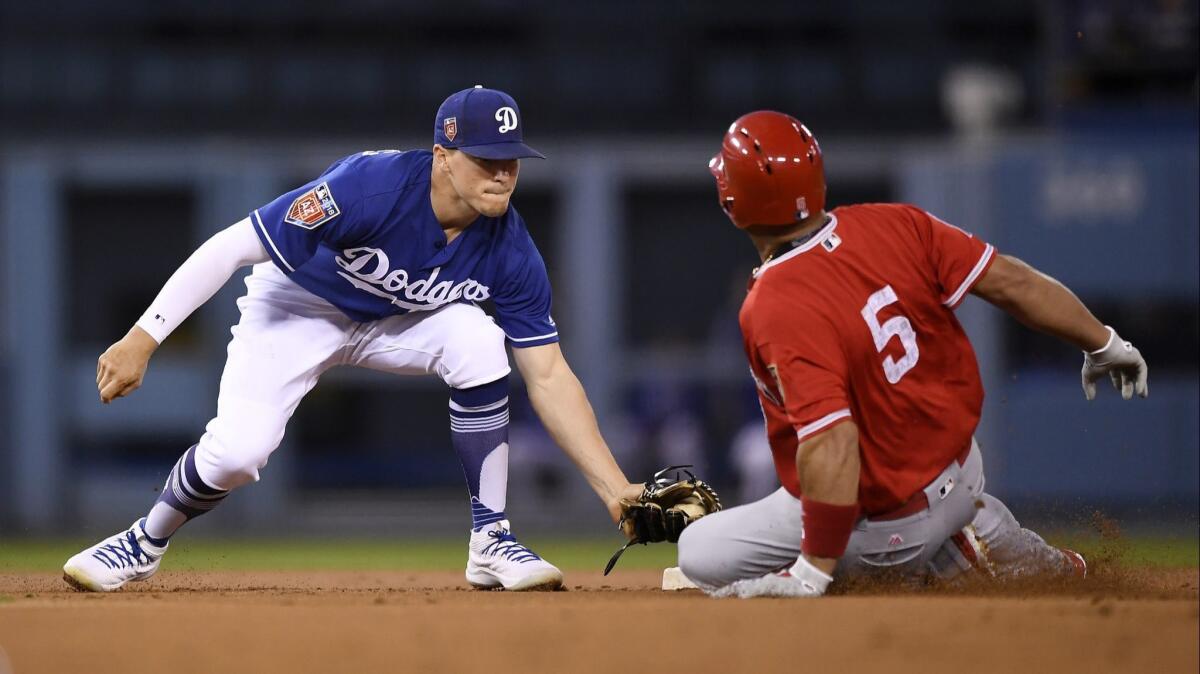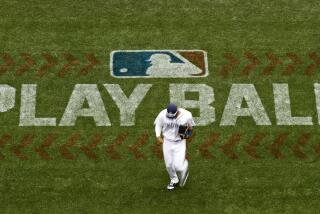Op-Ed: America needs baseball’s virtues more than ever

- Share via
Baseball has become countercultural in America. Its pacing defies our Twitter-addled era. The game denies instant gratification. Thousands of measurable events and matchups provide inarguable facts. The sport demands respect for history and context. Given the current political climate, the republic needs baseball more than ever.
As the country has sped up, baseball has gotten slower. The average nine-inning game takes over three hours — 13% longer than in 2005. There is no “running the clock” as there is in just about every other sport. Batters saunter to the plate and fiddle with batting gloves. Pitchers shake off signs, get set and then step off the mound. Major League Baseball hopes to quicken the pace by limiting the number of coaching visits to the mound and shortening breaks between innings. Players, bless them, have resisted a 20-second pitch clock.
For the record:
12:00 a.m. April 3, 2018Baseball — A March 28 Op Ed article about Major League Baseball said the league widened the strike zone in the 1960s. The strike zone was narrowed.
Baseball teaches delayed gratification. It lacks the constant movement of basketball or violent contact of football, and the pleasure of an inning-ending strikeout or run-saving catch comes only after a period of tense waiting. The exact opposite occurs, too. With the crowd on its feet during a go-ahead moment, a batter will foul off five pitches only to meekly ground out to first base.
Baseball also fosters a philosophical outlook. There are 162 regular season games; players and teams often recover from slow starts. Fans and players expect ups and downs. This is not the orientation of hyperbolic cable news shows or the incessant outrage traded on social media.
Baseball resists quick, uninformed judgments. Teams and players reveal their character over some 1,500 innings played each year. The sheer volume of data generated lends itself to debate, analysis and historical comparison. All major league players stand in relationship to the achievements of their forbearers.
Baseball resists quick, uninformed judgments. Teams and players reveal their character over some 1,500 innings played each year.
Baseball reminds us how important historical context is as well. No one forgets that baseball was racially segregated until Jackie Robinson took the field with the Brooklyn Dodgers in 1947. In 1920, when the league introduced the more tightly-wound “live ball,” sluggers such as Babe Ruth became stars of the game overnight. MLB added eight games to the regular season in the early 1960s, which made comparing the single-season achievements of pitchers and hitters difficult. With the growing dominance of pitchers during the late 1960s, the league narrowed the strike zone and lowered the pitcher’s mound five inches to help batters again. Such rule changes, of which there are many, mean that Babe Ruth can’t be neatly compared to Mike Trout.
MLB franchises are businesses designed to make money, but even the league’s distasteful attempts at spectacle — like halftime shows at the MLB Homerun Derby — cannot overwhelm the substance of our national pastime. At a moment when post-truth politics poisons our discourse, opening day can’t get here soon enough.
John R. Bawden is an associate professor of history at the University of Montevallo.
Follow the Opinion section on Twitter @latimesopinionand Facebook
UPDATES:
April 3: This article was updated to correct that the strike zone was narrowed in the 1960s, not widened.
More to Read
A cure for the common opinion
Get thought-provoking perspectives with our weekly newsletter.
You may occasionally receive promotional content from the Los Angeles Times.










